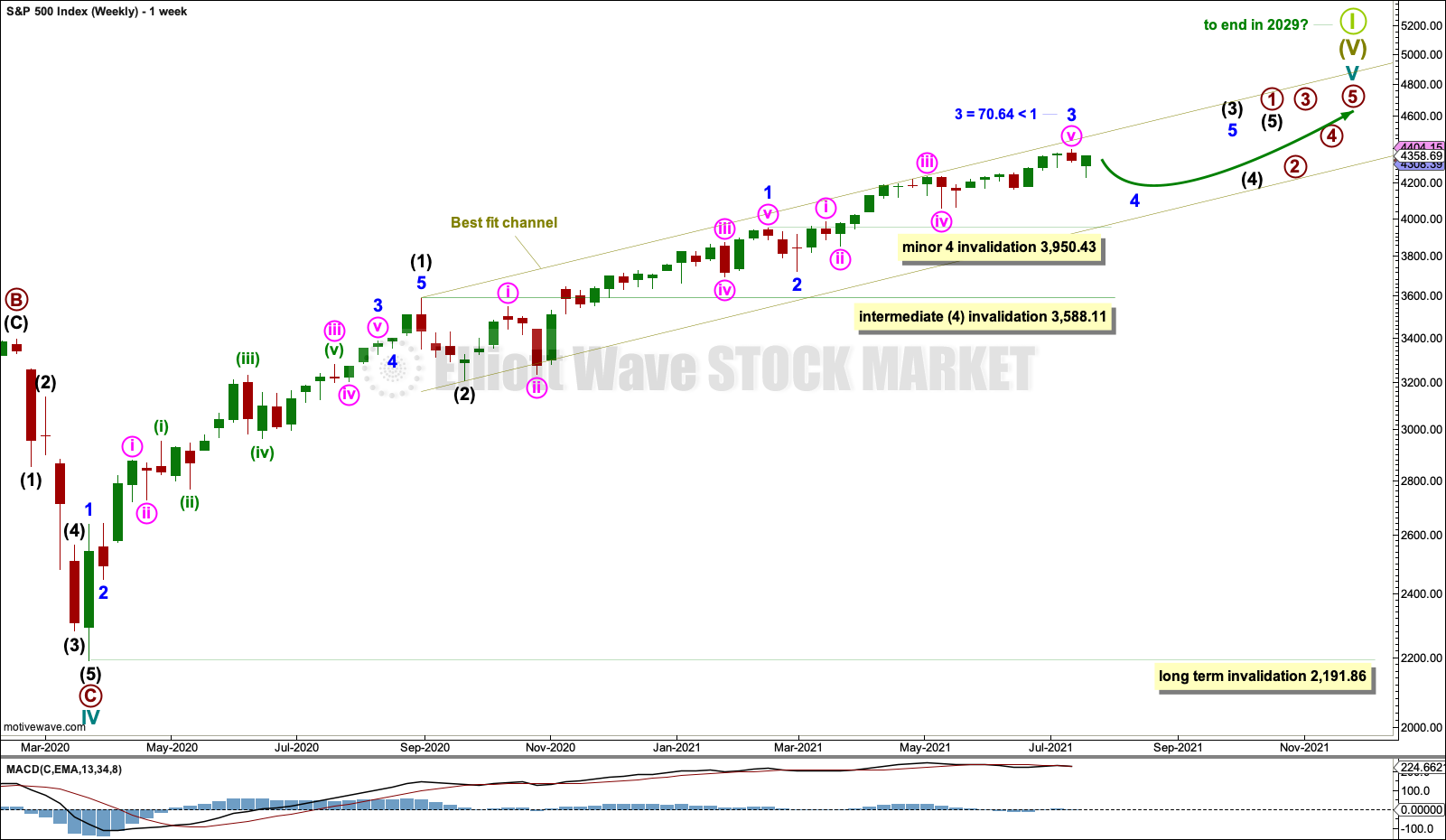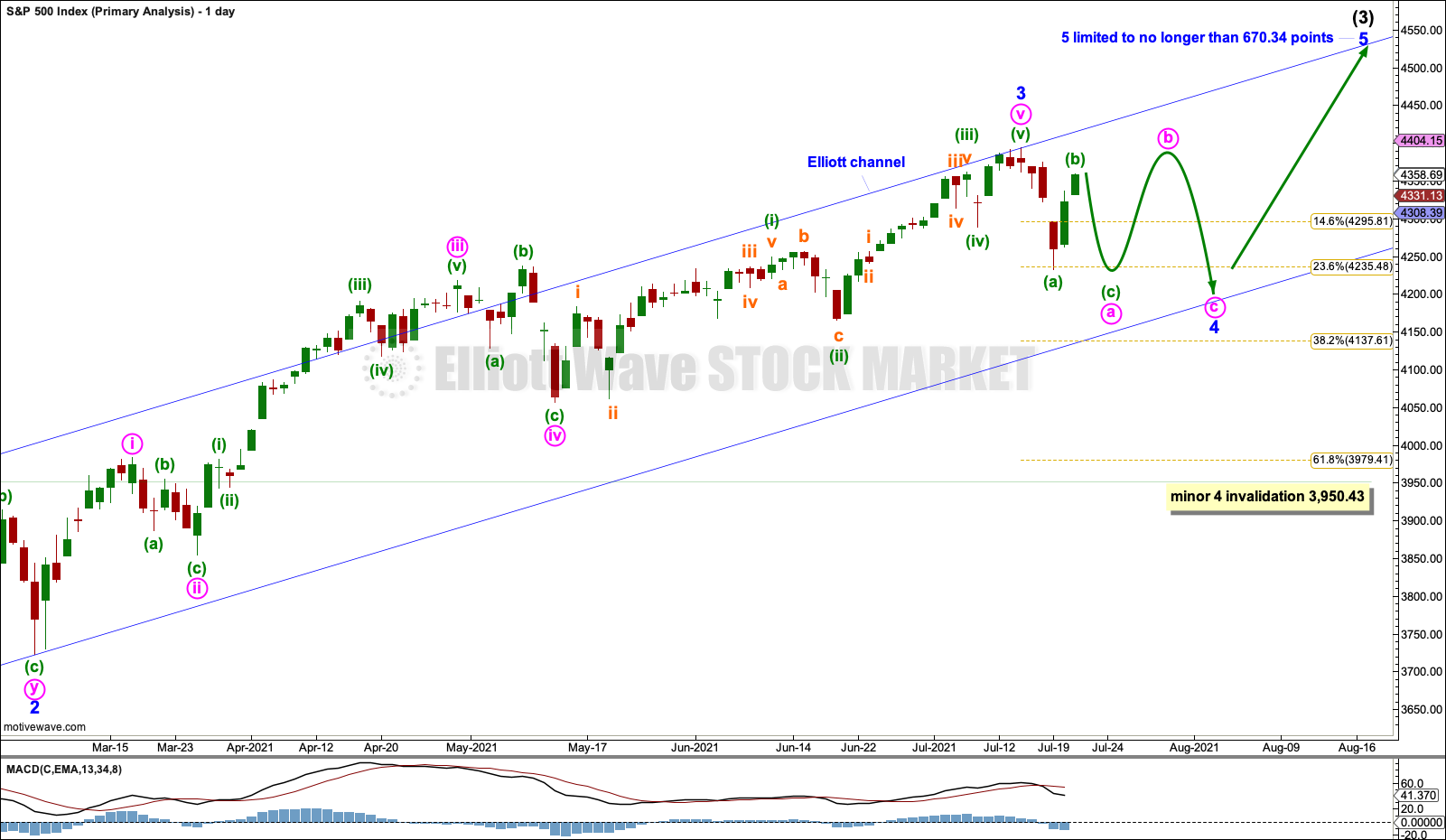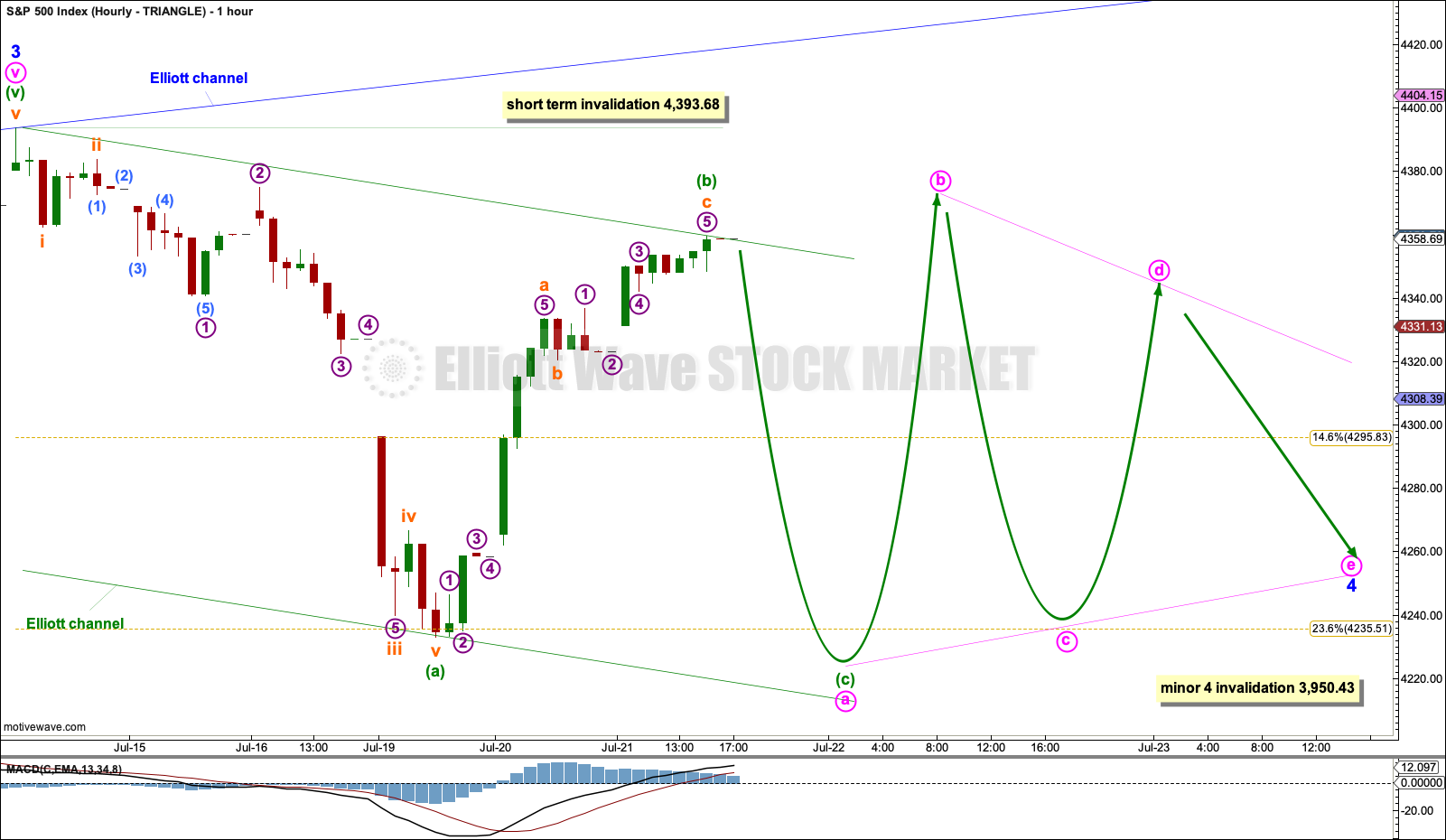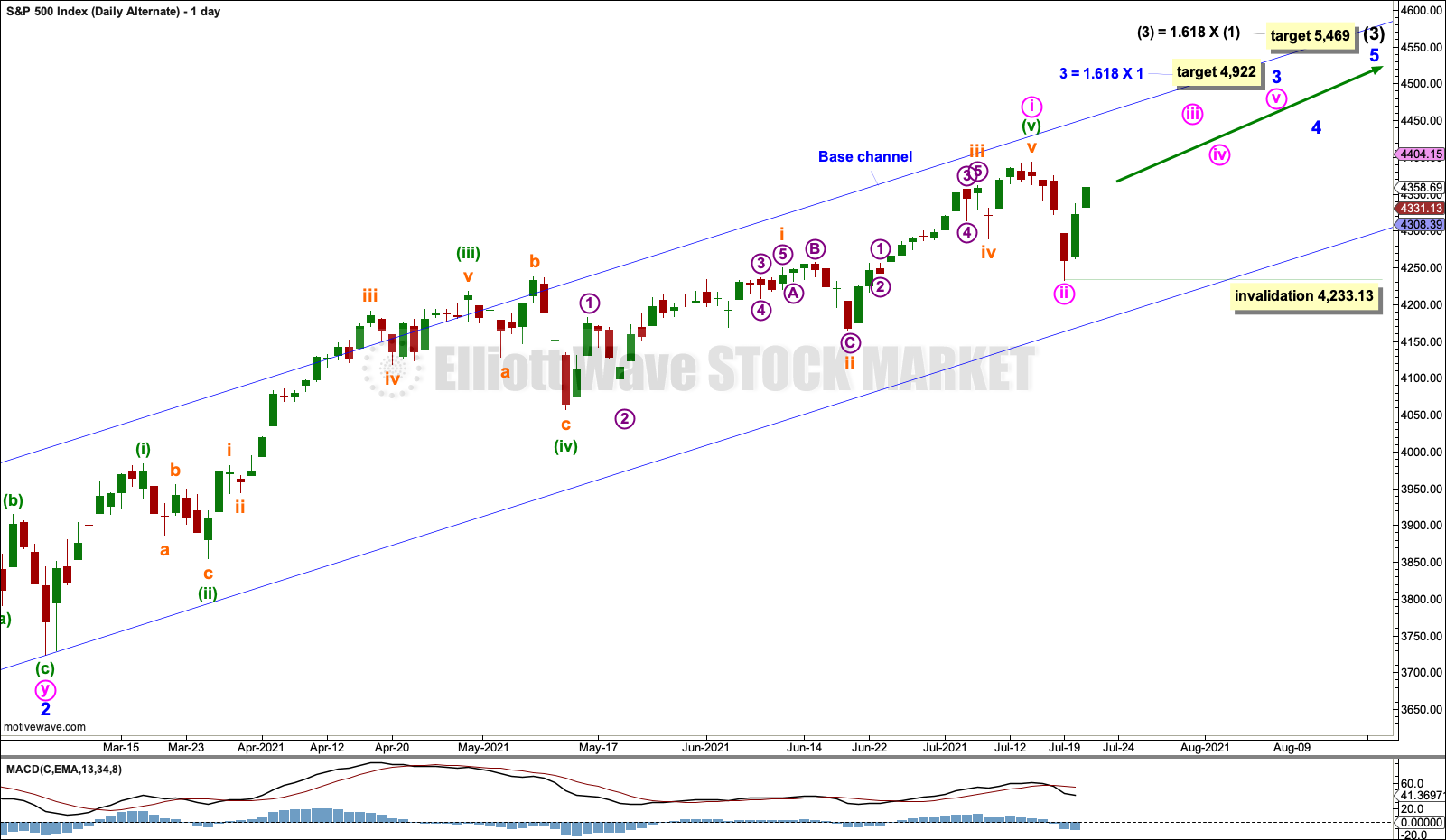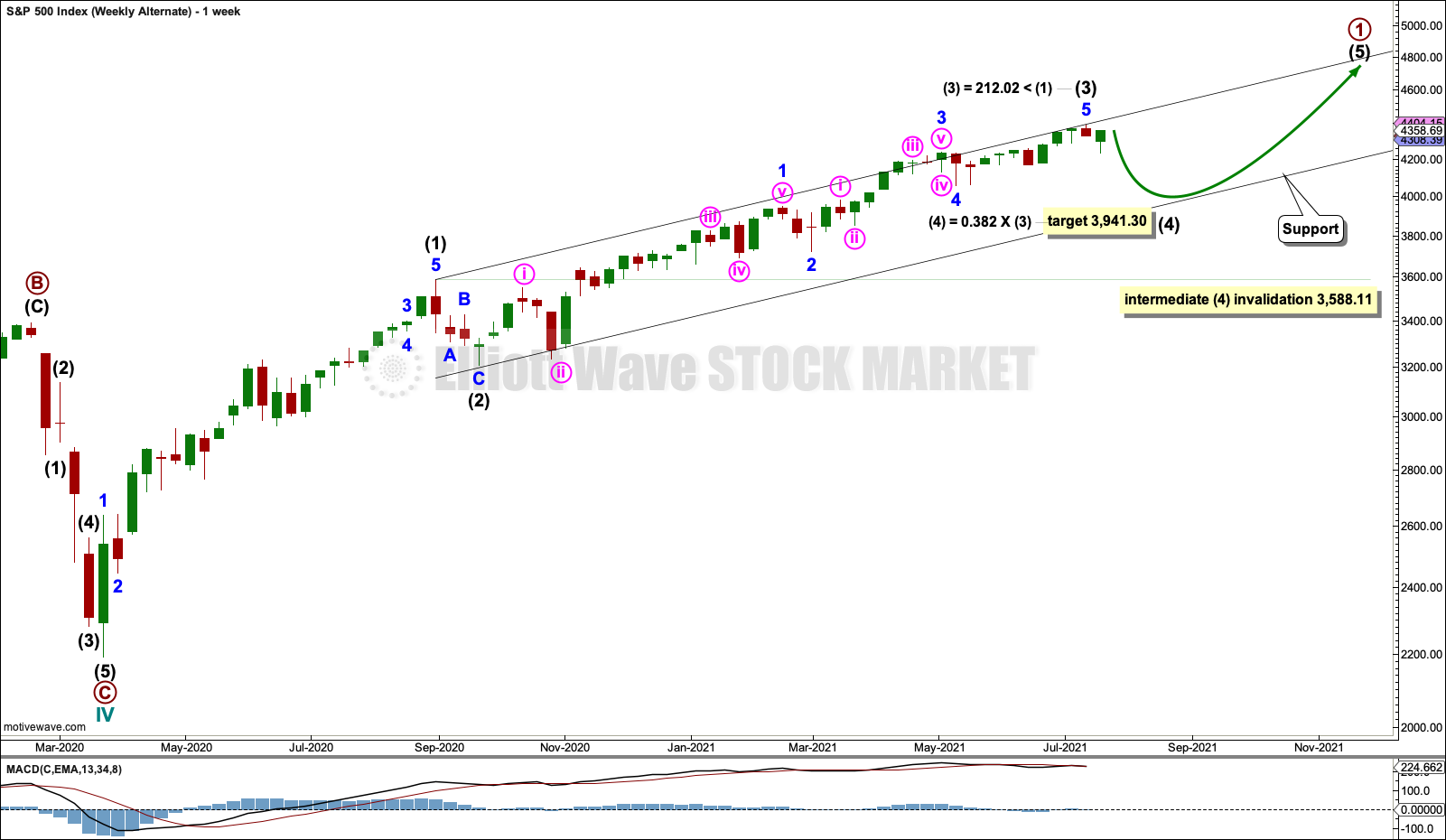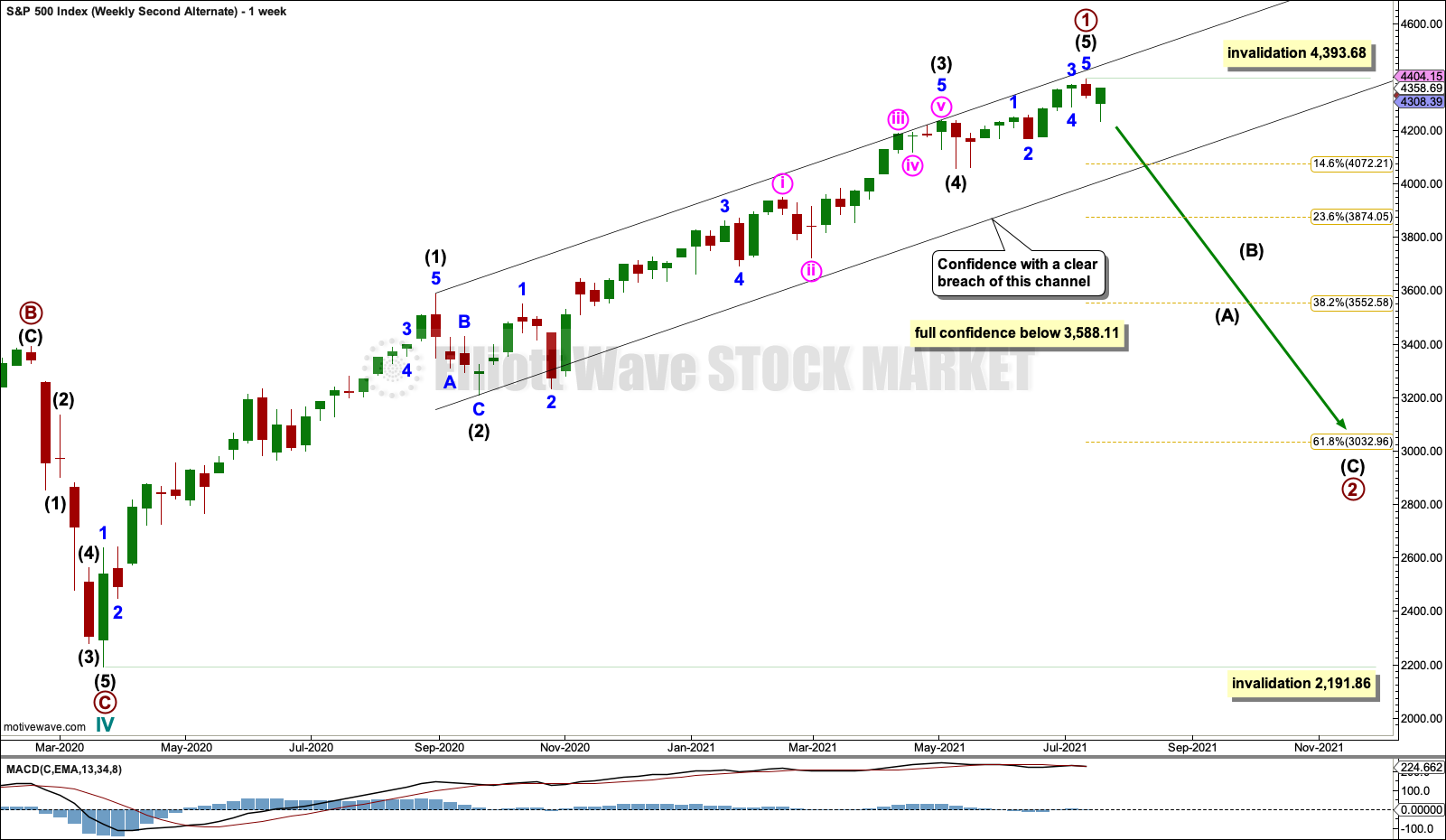S&P 500: Elliott Wave and Technical Analysis | Charts – July 21, 2021
All Elliott wave counts remain valid. A new Elliott wave count is today considered.
Summary: There is now a cluster of bearish signals from the AD line and short-term weak bearish divergence between price and RSI. Four Elliott wave counts are considered in order of probability:
1 – A minor degree fourth wave may continue lower and / or sideways for another three to six weeks. Support may be found about 4,235 or 4,137.65. The first level of support has been reached; price may remain at support or it may move lower to the next level.
2- The pullback is over and the upwards trend resumes to the next target at 4,922.
3 – An intermediate degree fourth wave may continue lower for about four to eight weeks. Support may be found about 3,941.4.
4 – A bear market may begin with little warning. It may last about two to a few months and may find support about 3,033, but it may end below this point. Final invalidation is at 2,191.86.
Reasons for decisions on probability are explained carefully in the analysis below.
The biggest picture, Grand Super Cycle analysis, is here.
Monthly charts are last updated here with video here.
MAIN ELLIOTT WAVE COUNT
WEEKLY CHART
Cycle wave V may last from one to several years. So far it is in its sixteenth month.
This wave count may allow time for the AD line to diverge from price as price makes final highs before the end of the bull market. The AD line most commonly diverges a minimum of 4 months prior to the end of a bull market. A longer divergence is positively correlated with a deeper bear market. A shorter divergence is positively correlated with a more shallow bear market. There is zero divergence at this stage.
A longer divergence between price and the AD line would be expected towards the end of Grand Super Cycle wave I.
It is possible that cycle wave V may continue until 2029, if the 2020s mirror the 1920s. Either March or October 2029 may be likely months for the bull market to end.
Cycle wave V would most likely subdivide as an impulse. But if overlapping develops, then an ending diagonal should be considered. This chart considers the more common impulse.
There is already a Fibonacci ratio between cycle waves I and III within Super Cycle wave (V). The S&P500 often exhibits a Fibonacci ratio between two of its actionary waves but rarely between all three; it is less likely that cycle wave V would exhibit a Fibonacci ratio. The target for Super Cycle wave (V) to end would best be calculated at primary degree, but that cannot be done until all of primary waves 1, 2, 3 and 4 are complete.
Primary wave 1 within cycle wave V may be incomplete. This gives a very bullish wave count, expecting a long duration for cycle wave V which has not yet passed its middle strongest portion.
Within primary wave 1: Intermediate waves (1) and (2) may be complete, and intermediate wave (3) may now be approaching an end.
Intermediate wave (4) may not move into intermediate wave (1) price territory below 3,588.11.
Within intermediate wave (3), minor waves 1, 2 and 3 may be complete. Minor wave 3 may be shorter than minor wave 1 by 70.64 points. This limits minor wave 5 to no longer than equality in length with minor wave 3. Minor wave 4 may have begun; it may not move into minor wave 1 price territory below 3,950.43.
A best fit channel is drawn about cycle wave V. Draw the first trend line from the end of intermediate wave (1) to the end of minute wave iii within minor wave 3, then place a parallel copy on the end of intermediate wave (2). The channel may need to be redrawn as price continues higher. The channel may show where price may find resistance and support along the way up.
DAILY CHART
Minor wave 2 subdivided as a double zigzag and lasted 12 sessions. Minor wave 4 may last about 3 to 6 weeks and may most likely subdivide as a flat, triangle or combination, which are often longer lasting than zigzags. Flats, triangles or combinations are choppy sideways movements with swings from resistance to support and back again. Price does not move in a straight line during these swings, so it will not be possible to know which of several Elliott wave structures minor wave 4 has subdivided as until it may be over.
Draw an Elliott channel. Draw the first trend line from the ends of minor waves 1 to 3, then place a parallel copy on the end of minor wave 2. Minor wave 4 may find support about the lower edge of this channel; it may continue to find support at the 0.236 Fibonacci ratio at 4,235.48.
Minor wave 4 may not move into minor wave 1 price territory below 3,950.43.
If minor wave 3 is over, then it would be 70.64 points shorter than minor wave 1. This limits minor wave 5 to no longer than equality in length with minor wave 3, so that the core Elliott rule stating a third wave may never be the shortest is met.
HOURLY CHART – COMBINATION OR FLAT
The hourly chart will be split into two ideas to show different possible structures for minor wave 4.
Minor wave 2 was a shallow 0.31 double zigzag, lasting 12 sessions. Minor wave 4 would least likely subdivide as a single or multiple zigzag and most likely subdivide as a combination, flat or triangle. This first hourly chart considers a combination or flat.
For reasonable proportion to minor wave 2, minor wave 4 would unlikely be over at the last low. It would most likely continue sideways for another one to three weeks.
If minor wave 4 subdivides as a combination, then within it the first structure may be an incomplete zigzag, labelled minute wave a. Within minute wave a: The first wave down labelled minuette wave (a) fits best as a five wave impulse, and minuette wave (b) may be over at today’s high (or it may continue). If minuette wave (a) is correctly labelled as a five, then minuette wave (b) may not move beyond its start above 4,393.68.
If minuette wave (b) is complete, then minuette wave (c) may now move lower. It would most likely make at least a slight new low below the end of minuette wave (a) at 4,233.13 to avoid a truncation.
When a zigzag may be complete, labelled minute wave a or w, then minute wave b or x may move higher and may make a new all time high if minor wave 4 subdivides as an expanded flat or combination.
Minor wave 4 may not move into minor wave 1 price territory below 3,950.43.
While this analysis now provides hourly charts for different possible structures for minor wave 4, it must be repeated that analysis during corrections is particularly difficult as multiple structures are possible. Focus should not be on identifying each smaller movement within the correction but on identifying when the correction may be complete and an upwards breakout may be expected.
HOURLY CHART – TRIANGLE
If minor wave 4 subdivides as a triangle, then within it minute wave a may be an incomplete zigzag.
Within minute wave a: Minuette waves (a) and (b) may be complete, and minuette wave (c) may move lower and should make at least a slight new low below the end of minuette wave (a) at 4,233.13 to avoid a truncation.
If minuette wave (b) continues higher, then it may not make a new high above the start of minuette wave (a) at 4,393.68.
Thereafter, minute wave b should move higher, most likely as a single zigzag. If minor wave 4 subdivides as a running triangle, then minute wave b may make a new all time high.
A triangle may last about three to five weeks.
ALTERNATE DAILY CHART
Today this alternate wave count is new and is placed in order of second probability to the main Elliott wave count, which is first.
If the degree of labelling within minor wave 3 is moved up one degree, then only minute wave i within minor wave 3 may be complete.
Minute wave ii within minor wave 3 may be over at the last low. A third wave up at minute, minor and intermediate degree may have just begun.
Targets are calculated for minor wave 3 and intermediate wave (3) that expect common Fibonacci ratios.
No second wave correction within minute wave iii may move beyond its start below 4,233.13.
ALTERNATE WEEKLY CHART
Considering the now well developed cluster of bearish signals from the AD line, it is time to consider a deeper or longer lasting correction may have arrived.
If intermediate wave (3) is over at the last high, then it would be shorter than intermediate wave (1) by 212.02 points. This market has a strong tendency for its third waves to extend, so this alternate must be judged to have a low probability for this reason.
At the last all time high, there was only 7 days of bearish divergence between price and the AD line, suggesting any pullbacks or consolidations developing here may more likely be short term in nature. But this does not support this alternate wave count (nor does it support the very bearish second alternate wave count below).
Intermediate wave (2) lasted 3 weeks, subdivided as a single zigzag, and was a shallow 0.27 correction of intermediate wave (1). Intermediate wave (4) may last 4 or more weeks and may be a slightly deeper sideways consolidation. Intermediate wave (4) may most likely subdivide as a flat, triangle or combination.
Intermediate wave (4) may not move into intermediate wave (1) price territory below 3,588.11.
SECOND ALTERNATE WEEKLY CHART
In just under 100 years there have been only three bear markets that occurred after there was no bearish divergence between price and the AD line: in 1946, 1976 and the last bear market of February to March 2020. It is possible that in current market conditions another bear market may begin here, with little warning. If it does, it then should be labelled primary wave 2.
If the trend channel about primary wave 1 is breached at the daily chart level with a full daily candlestick of downwards movement (not sideways), then this bearish alternate wave count may be considered. A preferred target for primary wave 2 would be the 0.618 Fibonacci ratio of primary wave 1 at 3,032.96, but it may be deeper than this. Primary wave 2 may last about two months, or it may possibly be longer lasting. Within primary wave 2, there should be a dead cat bounce for intermediate wave (B).
Primary wave 2 may not move beyond the start of primary wave 1 below 2,191.86.
TECHNICAL ANALYSIS
WEEKLY CHART

Click chart to enlarge. Chart courtesy of StockCharts.com.
Another Bearish Engulfing candlestick pattern has support from volume. There are two prior examples of Bearish Engulfing patterns on this chart that were not followed by any further downwards movement.
There is short-term bearish divergence between price and RSI, but it is weak. This suggests a pullback or consolidation here may more likely be shallow and short term in nature. This supports the main Elliott wave count.
DAILY CHART
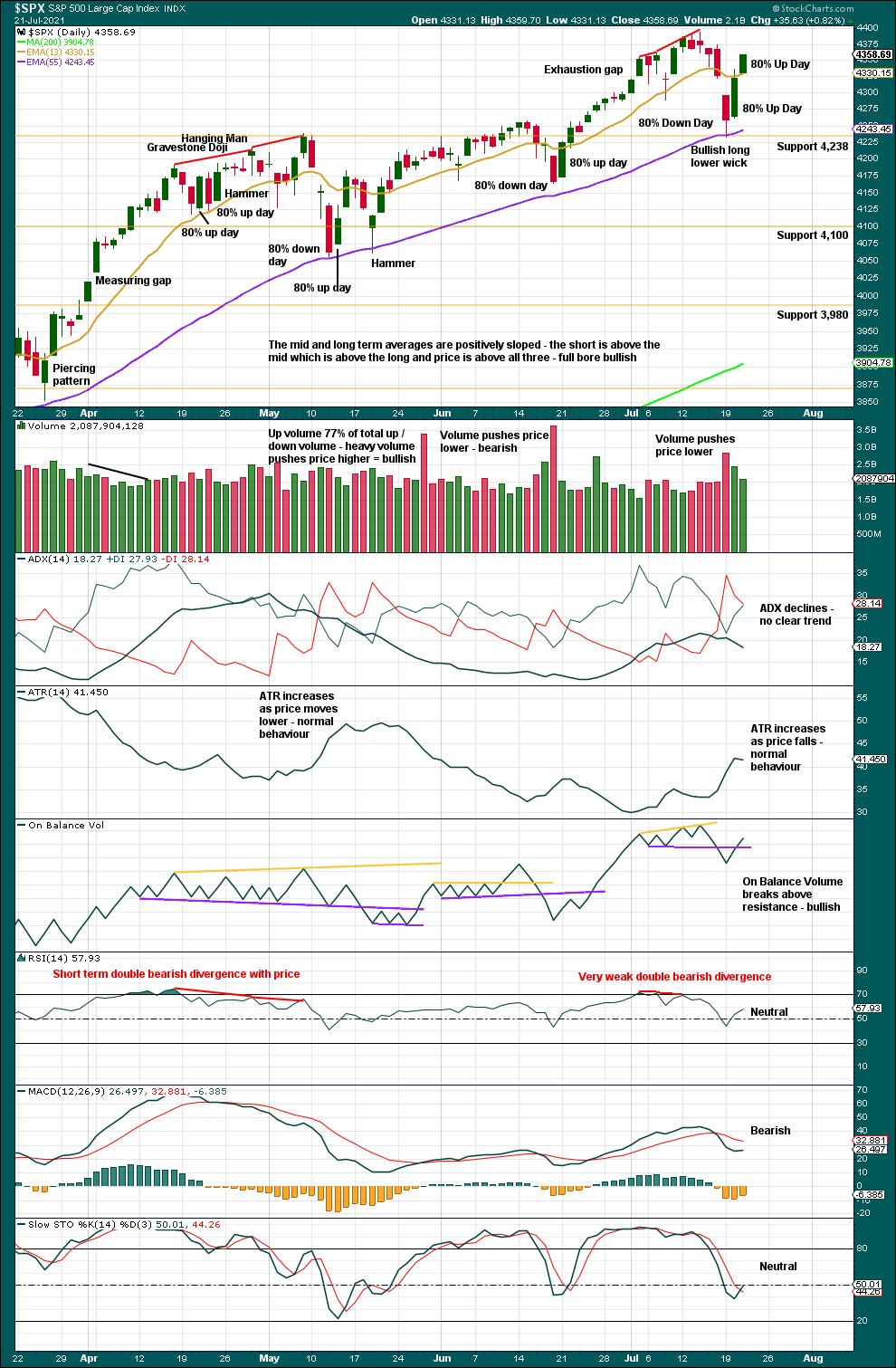
Click chart to enlarge. Chart courtesy of StockCharts.com.
Double bearish divergence between price and RSI is very weak and short term. Weaker divergence, which is short term, suggests a more shallow and short-term pullback or consolidation. This supports the main Elliott wave count.
Two back to back 80% up days are now complete, although they have not come after a 90% or two back to back 80% down days, so this is not enough for confidence in a sustainable low.
The last swing low on the 18th of June though did come with one 80% down day followed by one 80% up day.
However, on the 18th of June there was not a reasonable cluster of bearish signals from the AD line, short-term bearish divergence between price and RSI, nor a reasonable cluster of bearish signals from inverted VIX. Today the bearish signals are stronger. A consolidation or pullback may continue here to relieve this bearishness and set up for the next advance.
BREADTH – AD LINE
WEEKLY CHART
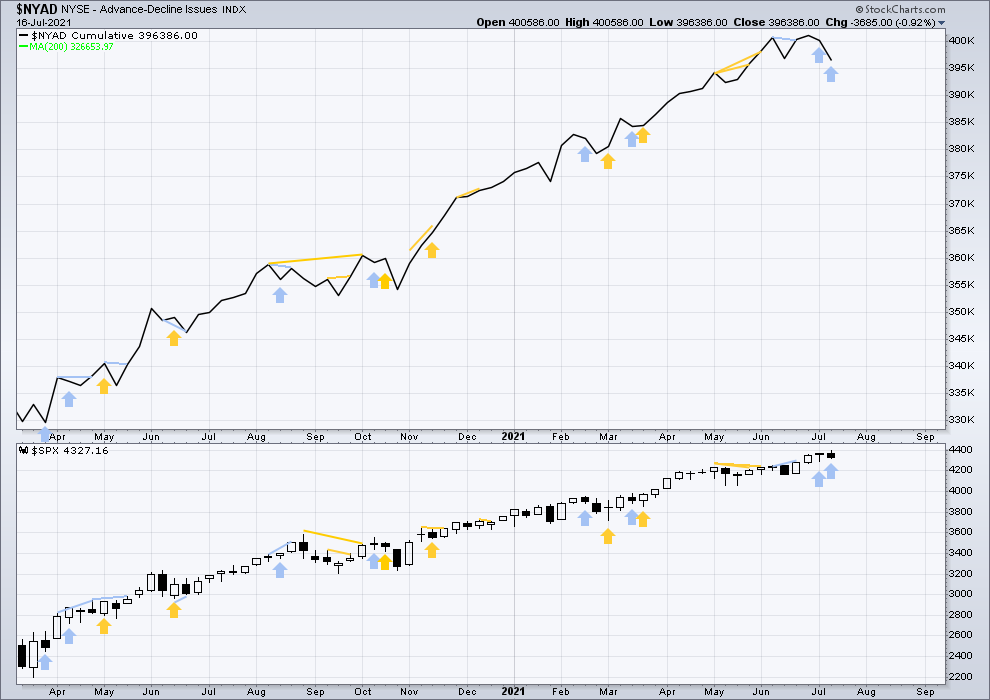
Click chart to enlarge. Chart courtesy of StockCharts.com. So that colour blind members are included, bearish signals will be noted with blue and bullish signals with yellow.
Breadth should be read as a leading indicator.
Lowry’s Operating Companies Only AD line has made a new all time high on the 8th of June. There is now over one and a half months of bearish divergence between the OCO AD line and price. This supports the first alternate Elliott wave count but not necessarily the second alternate Elliott wave count.
Large caps all time high: 4,393.68 on Jul 14, 2021.
Mid caps all time high: 2,780.08 on May 10, 2021.
Small caps all time high: 1,417.45 on June 8, 2021.
With just over 2 months of weakness in small and mid caps, some pullback or consolidation may result sooner. The Elliott wave count and supporting technical analysis suggest it may have begun.
Last week price has moved higher, but the AD line has moved lower. At last week’s new all time high for price, there is now just two weeks of short-term bearish divergence.
DAILY CHART
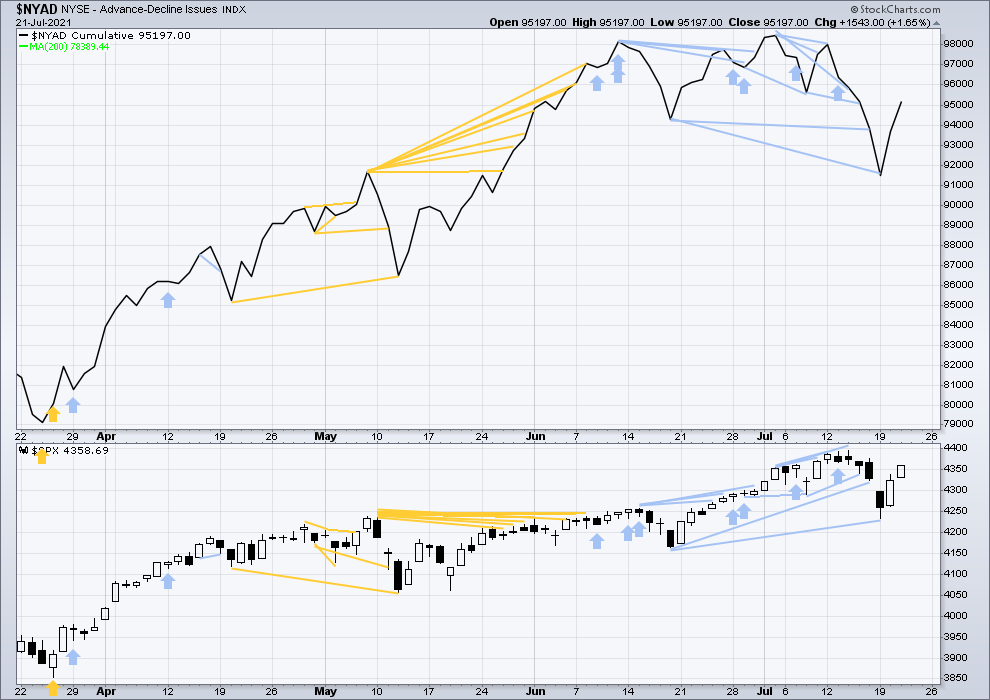
Click chart to enlarge. Chart courtesy of StockCharts.com. So that colour blind members are included, bearish signals will be noted with blue and bullish signals with yellow.
Again, price and the AD line have both moved higher. The AD line is not moving up with more strength than price. There is no new bullish signal. A cluster of bearish signals remains.
The last all time high for the AD line occurred just seven days prior to the last all time high in price. With only one week of bearish divergence, probability favours a short-term pullback or consolidation and not a fully fledged bear market. This suggests the main Elliott wave count may be preferred.
VOLATILITY – INVERTED VIX CHART
WEEKLY CHART

Click chart to enlarge. Chart courtesy of StockCharts.com. So that colour blind members are included, bearish signals will be noted with blue and bullish signals with yellow.
Inverted VIX remains well below all time highs. The all time high for inverted VIX was in the week beginning October 30, 2017. There is over 3 years of bearish divergence between price and inverted VIX. This bearish divergence may develop further before the bull market ends. It may be a very early indicator of an upcoming bear market, but it is not proving to be useful in timing. It may support the second alternate Elliott wave count.
Price for the second week in a row has moved higher, but inverted VIX has moved lower. Long-term and mid-term bearish divergence remains.
Comparing VIX and VVIX at the weekly chart level:
Last week both VIX and VVIX have moved higher. There is no new short-term divergence.
DAILY CHART
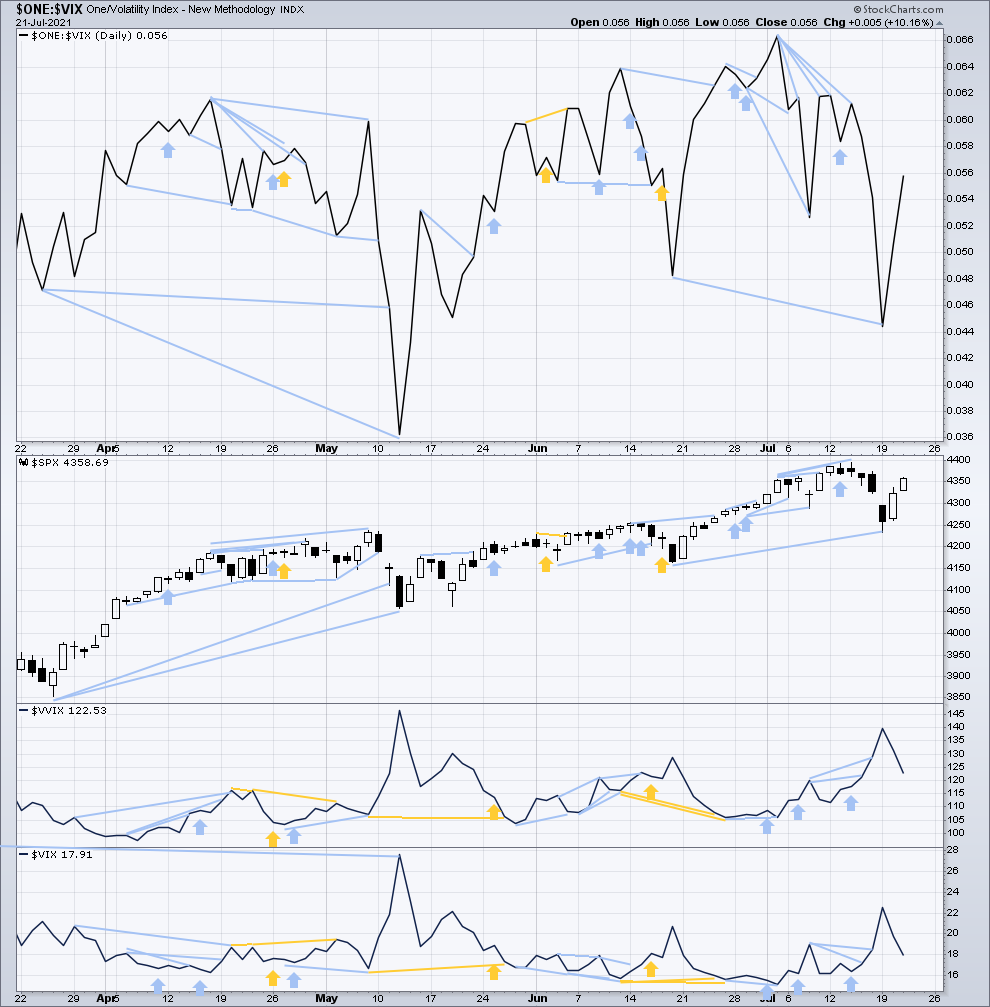
Click chart to enlarge. Chart courtesy of StockCharts.com. So that colour blind members are included, bearish signals will be noted with blue and bullish signals with yellow.
Again, both price and inverted VIX have moved higher. Inverted VIX is not moving higher any faster than price. There is no new short-term divergence. A cluster of bearish divergence remains.
A cluster of short-term bearish divergence remains and supports the main Elliott wave count.
Comparing VIX and VVIX at the daily chart level:
Today both VIX and VVIX have moved lower. There is no new short-term divergence.
DOW THEORY
Dow Theory confirms a new bull market with new highs made on a closing basis:
DJIA: 29,568.57 – closed above on 16th November 2020.
DJT: 11,623.58 – closed above on 7th October 2020.
Most recently, on 10th May 2021 both DJIA and DJT have made new all time highs. An ongoing bull market is again confirmed by Dow Theory.
Adding in the S&P and Nasdaq for an extended Dow Theory, confirmation of a bull market would require new highs made on a closing basis:
S&P500: 3,393.52 – closed above on 21st August 2020.
Nasdaq: 9,838.37 – closed above on June 8, 2020.
The following major swing lows would need to be seen on a closing basis for Dow Theory to confirm a change from bull to a bear market:
DJIA: 18,213.65
DJT: 6,481.20
Adding in the S&P and Nasdaq for an extended Dow Theory, confirmation of a new bear market would require new lows on a closing basis:
S&P500: 2,191.86
Nasdaq: 6,631.42
Published @ 07:59 p.m. ET.
—
Careful risk management protects your trading account(s).
Follow my two Golden Rules:
1. Always trade with stops.
2. Risk only 1-5% of equity on any one trade.
—
New updates to this analysis are in bold.
—

